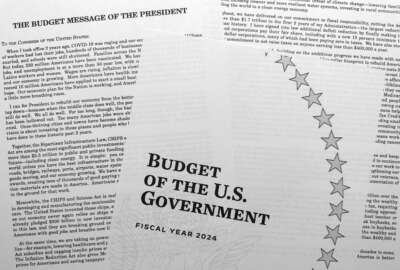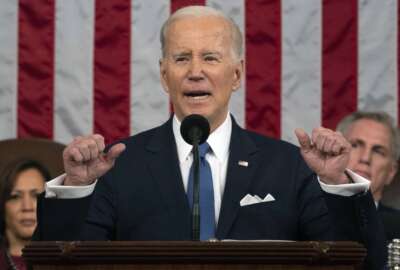
Biden plans federal pay compression fix, streamlined hiring in FY 24 budget
The Biden administration's agenda for the federal workforce next year is coming into focus, with the release of more details supporting its fiscal 2024 budget...
The Biden administration’s agenda for the federal workforce next year is coming into focus, with the release of more details supporting its fiscal 2024 budget request.
While the administration last week proposed giving federal employees a 5.2% average pay raise in 2024, the White House is also calling on Congress to introduce legislation that would allow more federal executives to feel the full effect of any future pay raise.
The Biden administration hinted at upcoming legislation that would address pay compression felt by members of the Senior Executive Service, higher grade General Schedule employees, as well as blue-collar workers under the Federal Wage Grade.
The Office of Management and Budget, in one of its analytical perspectives supplementing the Biden administration’s 2024 budget request, said federal workers’ pay is “increasingly hamstrung” by statutory requirements “that curb the ability of agencies to reward talent, including for specialized occupations, in a national competitive job environment.”
“As agencies confront the need for evolving digital and technological skill sets to assure service delivery for the public, their recruitment and retention toolboxes lack the means to tackle core compensation needs, particularly for senior level management officials charged with overseeing large numbers of projects, personnel, and funds,” OMB wrote.
The Biden administration is calling on lawmakers to address federal pay compression as the Office of Personnel Management looks to finalize a Special Salary Rate for federal IT and cyber personnel working in 2210 classified positions.
Preliminary details of the long-awaited SSR show that entry-level and mid-career federal employees working in IT and cyber jobs will see the biggest increase in overall pay.
But senior IT employees at the upper levels of the GS pay scale would see a more modest pay increase, and in some cases, would not see any additional increase in pay, because of current salary caps that apply to all federal employees under the GS pay scale.
Salaries for career federal employees, under law, can’t exceed the pay rates for political appointees and others at level IV of the Executive Schedule, which is currently $183,500.
With this cap in place, a growing number of long-time career feds are running up against a pay ceiling that’s usually fixed in place or raised incrementally when addressed by Congress.
“The federal government, as a model employer, must act to enable a robust and capable civil service that is resilient to take on future challenges,” OMB wrote.
The administration expects to spend $271 billion in 2024 to pay the federal workforce — a more than 9% increase from this year. That doesn’t include an estimated $119 billion to pay for benefits for federal employees and retirees — a more than 8% increase from current levels.
Reintroducing bill to ban Schedule F
The Biden administration also hinted at lawmakers soon reintroducing legislation that would prevent future administrations from creating a “Schedule F” of the excepted service that would make it easier to fire federal employees in policymaking positions.
Former President Donald Trump created “Schedule F” in an executive order that President Joe Biden repealed in his first week in office.
Lawmakers originally included the Preventing a Patronage System Act in the 2023 National Defense Authorization, but was removed in the final version of the NDAA. The bill would have prevented any administration from bringing back Schedule F.
“The administration looks forward to working with the Congress on this proposal,” OMB wrote. “The administration continues to demonstrate its publicly sustained commitment to the career workforce by opposing attempts to weaken the non-partisan, merit-based civil service,” the White House wrote.
‘Talent teams’ to streamline federal hiring
The administration is also looking to create 26 “talent teams” across the federal workforce. The teams would make skills-based assessments and pooled hiring actions a more common practice across federal hiring.
The teams would help scale up Subject-Matter Expert Qualification Assessments (SME-QAs). The process has agencies bring in current employees who are experts in a given field to help the HR office vet and hire candidates.
The U.S. Digital Service developed the SME-QA process to help agencies assess applicants’ qualifications for technical positions.
The teams would also promote the use of pooled hiring and shared certificates when multiple agencies are looking to hire the same type of specialists, such as cybersecurity experts or data scientists.
“In total, these efforts are designed to help managers consider the most qualified applications and hire quality candidates, while also allowing applicants who are qualified but not ultimately selected to still receive offers from other federal agencies,” OMB wrote.
OPM’s new Hiring Experience Group and OMB spent much of last year helping agencies conduct pooled hiring action and piloted the first use of shared certs across agencies.
Agencies have used pooled hiring to hire customer experience experts, organizational psychologists, grants management specialists, contract specialists and data scientists.
“Pooled hiring actions using technical assessments have resulted in improved applicant experience as well as increased hiring manager satisfaction, as they are able to bring in the talent they need,” OMB wrote.
Staffing up agency HR offices to ‘rebuild’ workforce
The budget request also directs agencies to staff up their human resources offices to become “capable of rebuilding and strengthening the workforce.”
There are about 47,000 HR professionals in the federal workforce, but retention rates for HR management experts have been consistently falling behind the governmentwide average.
The average retention rate for the federal workforce is 77.2%, but federal HR officials have a 69.7% average retention rate.
To slow the exodus of HR professionals, the Biden administration is planning to create a new senior executive position at OPM focused on the development and career paths for the federal HR workforce.
The IRS and the Veterans Affairs Department, with large-scale hiring efforts underway, are looking at ways to beef up their own HR offices in an effort to “hire the hirers.”
On a governmentwide scale, additional HR expertise is needed as OPM helps agencies staff up under the Bipartisan Infrastructure Law.
Within the first year of the BIL, a “tiger team” at OPM helped agencies hire 3,500 new federal employees across 90 different occupations.
Those include scientists hired to combat climate change, engineers to repair and rebuild roads and bridges and workers to help ensure communities have access to clean water.
OPM helped agencies get more than halfway to their BIL hiring goals by the end of fiscal 2022 — and expects to get covered agencies to meet 75% of their hiring goals under the legislation by the end of fiscal 2023.
“As rebuilding efforts continue, hiring in these mission-essential functions will continue at an accelerated pace — while the federal government also seeks to develop its posture as a modern employer of choice, able to engage and retain the workers we hire,” OMB wrote.
The White House cites the skills gaps in the HR workforce as a “perennial concern,” often raised by the Government Accountability Office and the National Association of Public Administration,
“OPM and federal agencies are working in partnership to identify and expand awareness of approaches to development to build the technical and transformational skills needed in today’s HR workforce, map career pathways for current HR professionals, early career talent, and workers with transferable skills, and develop a centralized technology hub to provide access to these resources,” OMB wrote.
Reimaging the federal workplace
The Biden administration is also directing agencies to rethink their office space needs, as hybrid and remote work schedules have become more commonplace at agencies since the start of the COVID-19 pandemic.
“Going forward, agencies need to be strategically prepared for evolving work environments, where teams are likely to be more distributed on a continual basis than in the past. This shift will lead to increased reliance upon enhanced technological tools, cross-collaboration, and new methods of worker engagement,” OMB wrote.
The 2023 omnibus spending bill directed the General Services Administration to provide regular briefings to the House and Senate appropriations committees on how agencies can reduce their office space requirements “based on the lessons learned from the use of telework during the pandemic.”
OMB, in a memo in July 2022, directed agencies to rethink their office space needs for the future of work in the federal sector. OMB gave agencies until December 2022 to submit their capital plans, which will outline workspace needs through 2028.
“Like workers across the nation, federal employees have continued to perform their duties, no matter the location,” OMB wrote.
OPM recently issued a memo to agencies encouraging the use of hybrid and remote work as part of the “future of work.”
Copyright © 2025 Federal News Network. All rights reserved. This website is not intended for users located within the European Economic Area.
Jory Heckman is a reporter at Federal News Network covering U.S. Postal Service, IRS, big data and technology issues.
Follow @jheckmanWFED





